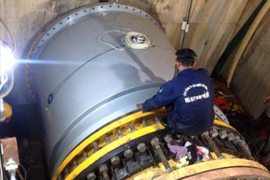
12 Questions To Help You To Choose The Right Control Valve
1. What is my application?
Water (treatment, transmission and distribution), Irrigation, Fire protection, Industry, Dams and hydropower.
Comments: Except Fire Protection which requires RAF and specific approvals, and RAF-P only suitable for Irrigation, all applications can be controlled by the full portfolio.
2. What is the parameter I want to control: Pressure – Level – Flow?
Remember that control valves allow the control of one, two or three parameters at the same time. Most of the time, one parameter is chosen, but considering the TALIS Control Valve range, solutions are quite unlimited.
Comments: In the following pages, each type of Automatic Control Valves is divided for each parameter. Actuated Needle valves for which ones an automate and sensors have to be installed by the customer are not concerned.
3. What is the diameter of the installation (before sizing the control valve)?
The basis to work on the project despite the fact that TALIS Control Valves potentially allow a smaller diameter.
Comments: some Automatic Control Valves are unavailable from a certain diameter. For example, RAY range is [50 to 250mm] and RAF range is [40 to 400mm]: if you work with pipes DN 1000, no need to consider these types.
4. What is the nominal pressure of the installation?
Sometimes, installations are made in a higher nominal pressure than normally requested. In order to avoid any disappointment (especially when the project is to replace another component), it is important to get the right connections!
Comments: If PN 16 is available for all the TALIS Control Valve range, PN 25 and PN 40 can be approached with Hydrobloc/Monostab/G Type and Needle valves/Flow Control. More than PN 40? Needle valves and G Type are the answers.
5. What are the maximum and the minimum pressures at the inlet of the control valve I want to install?
The maximum pressure will help to define the right PN and partially the size of the control valve. Do not forget that inlet pressure may vary (head losses in a network due to the flowrate, leaks, level in a reservoir or a dam etc...).
6. What is, or will be, the outlet pressure or the min and max outlet pressure?
Most control valves deliver the flow at the same outlet pressure (which can be adjustable as it is possible on a TALIS Pressure Reducing Valve). Sometimes, outlet pressure may vary (level in the reservoir to fulfill, high temporary consumption in an industrial area or farmland area etc…).
Comments: these criteria are important to analyse cavitation risks and also opening curves. If Needle Valves are especially dedicated for high operating conditions, Hydrobloc with anti-cavitation device and G Type are also a right altern ative.
7. What are the lowest flowrate (can be 0) and the highest flowrate?
Lowest flow is not an issue generally. All TALIS Control Valves are watertight at no flow rate. But it could be taken into account when the project requires a specific design or to confirm cavitation risks. Regarding highest flowrate, it is important to consider the velocity in the control valve and also head losses generated in itself.
8. Power supply on field or not?
TALIS Automatic Control Valves do not require a power supply. But it is necessary for actuated control valves or electrical control valves working with solenoid(s).
Comments: Generally, when control is provided by an automate, electricity is present. Except Monostab which cannot be actuated, TALIS Automatic Control valves can be controlled with low voltage (from 6V) while Actuated Needle Valves and Flow Control require 230V or 400V.
9. Do I want an actuator?
Different actuators are available, electric, pneumatic, hydro-electric, float electric etc… Whatever the type of actuator, there are also automatic controllers (with or without remote control) and, optionally, sensors. From these, numerous control possibilities can be achieved.
TALIS teams help you in order to choose the right actuator and the right control valve regarding what you want to do.
Comments: generally, these type of actuators are dedicated for Needle Valves and Flow Control.
10. Do I want a manual command?
Manual command is available for the whole full range, except for direct acting control valves (technically impossible).
We consider 2 types of manual command:
- Permanent manual control.
- Safety manual command (in case of problems on the network, emergency or malfunction).
Comments: by its flexibility, TALIS range offers a significant number of options for all types of Control Valves, except Monostab (technically impossible).
11. Do I want an automatic system power free?
- If yes, TALIS utomatic control valves work with fluid pressure only and provide a solution to meet your request.
- If no, step by step, electric or actuated TALIS control valves also provide a solution.
12. Do I have to consider another critical point?
(can be to sustain the inlet pressure, ensure automatic closing or opening in case of power fail, or provide additional security)
Sometimes the main function of TALIS control valves is so important that additional functions (such as security against power failure or low pressure) are overlooked. Work with our teams to see if additional equipment can be integrated. And keep in mind that simplicity is often a key success factor in network system operations.
LAC VIET CONSULTANT TRADE JOINT STOCK COMPANY is currently the authorized distributor in Northern Vietnam for the equipment manufactured by BAYARD a brand by TALIS in the Vietnamese market. The genuine BAYARD products that our company has been and is distributing include:
- BAYARD Intelligent Pressure Reducing Valve PRV (France)
- BAYARD K111 Hydrostab Full Port Pressure Reducing Valve PRV
- BAYARD HYDRELEC Control Valve - Series K4 21 or K4 31
-----------------------------------------
- ⚜️ Cell phone/Zalo/Whatsapp: 091 8182 587
- ⚜️ Email: hoangcuong@lacvietco-jsc.com.vn
-----------------------------------------







